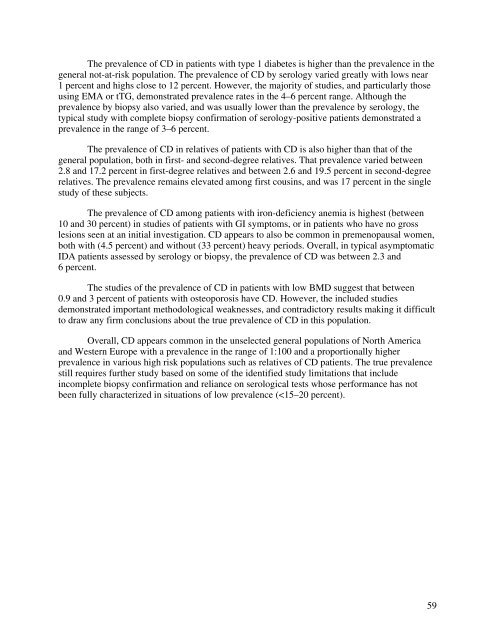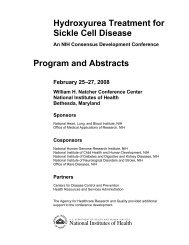Celiac Disease - NIH Consensus Development Program - National ...
Celiac Disease - NIH Consensus Development Program - National ...
Celiac Disease - NIH Consensus Development Program - National ...
You also want an ePaper? Increase the reach of your titles
YUMPU automatically turns print PDFs into web optimized ePapers that Google loves.
The prevalence of CD in patients with type 1 diabetes is higher than the prevalence in thegeneral not-at-risk population. The prevalence of CD by serology varied greatly with lows near1 percent and highs close to 12 percent. However, the majority of studies, and particularly thoseusing EMA or tTG, demonstrated prevalence rates in the 4–6 percent range. Although theprevalence by biopsy also varied, and was usually lower than the prevalence by serology, thetypical study with complete biopsy confirmation of serology-positive patients demonstrated aprevalence in the range of 3–6 percent.The prevalence of CD in relatives of patients with CD is also higher than that of thegeneral population, both in first- and second-degree relatives. That prevalence varied between2.8 and 17.2 percent in first-degree relatives and between 2.6 and 19.5 percent in second-degreerelatives. The prevalence remains elevated among first cousins, and was 17 percent in the singlestudy of these subjects.The prevalence of CD among patients with iron-deficiency anemia is highest (between10 and 30 percent) in studies of patients with GI symptoms, or in patients who have no grosslesions seen at an initial investigation. CD appears to also be common in premenopausal women,both with (4.5 percent) and without (33 percent) heavy periods. Overall, in typical asymptomaticIDA patients assessed by serology or biopsy, the prevalence of CD was between 2.3 and6 percent.The studies of the prevalence of CD in patients with low BMD suggest that between0.9 and 3 percent of patients with osteoporosis have CD. However, the included studiesdemonstrated important methodological weaknesses, and contradictory results making it difficultto draw any firm conclusions about the true prevalence of CD in this population.Overall, CD appears common in the unselected general populations of North Americaand Western Europe with a prevalence in the range of 1:100 and a proportionally higherprevalence in various high risk populations such as relatives of CD patients. The true prevalencestill requires further study based on some of the identified study limitations that includeincomplete biopsy confirmation and reliance on serological tests whose performance has notbeen fully characterized in situations of low prevalence (







